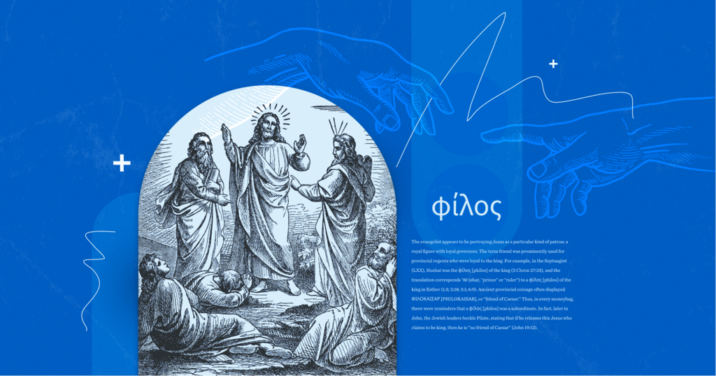Perhaps you’ve heard it spoken, read it on a T-shirt, or heard it in a song.
Jesus wants to be your friend.
Jesus is my best friend.
What a friend we have in Jesus.
In some ways, the idea of friendship with Jesus is appropriate. Jesus taught that his followers can be connected as closely to him as a vine to branches (John 15:4). Paul labored to know him (Phil 3:1). Christ understands us (Heb 4:15).
But in other ways, saying that Jesus is a friend can lead to a serious error. In our modern Western culture, friendship assumes equality. When we describe a friend, we’re usually talking about a same-level, horizontal relationship. We use the terms “buddy,” “pal,” or “homeboy.” We might seek out advice from people who fall into this category, but we are free to choose whether or not to follow their counsel.
If we say that Jesus is our friend without careful examination of what we mean, we risk seeing his teachings as optional.
The patron-client relationship
Nowhere in Scripture is it taught that Jesus Christ is our friend. Let’s not forget that Jesus is the King; he is the Christ. For those who follow him, we call him “Lord” because we submit to him. We worship him and respond to his commandments with obedience.
The scriptural teaching that most connects Jesus with friendship is John 15:13–15:
Greater love has no one than this, that someone lay down his life for his friends. You are my friends if you do what I command you. No longer do I call you servants, for the servant does not know what his master is doing; but I have called you friends, for all that I have heard from my Father I have made known to you.
With this passage in view, I will make the case that Jesus is not teaching that his disciples become his equals. Instead, Jesus is using imagery derived from the Greco-Roman custom of patronage. His original hearers would have understood that Jesus is superior to his followers in an uneven, vertical relationship. This is the best explanation of the “greater love” statement in John 15:13.1
Patronal relationships were common in the world of Jesus’s disciples. People of low social status, finding it difficult to have access to goods and services, would often seek someone of higher status to help them meet their needs. If the person of influence granted their request, the two would enter into a “patron-client relationship.”
Patron-client relationships, which Seneca called the chief bond of society (On Benefits 1.4.2), were defined by asymmetry, longevity, and reciprocity. First, the patron would be superior to the client, expecting the client to fulfill certain duties. Second, the client would pledge lifelong allegiance to the patron, an arrangement of servitude that would often pass on to subsequent generations. Third, the patron-client relationship would be characterized by reciprocity: a patron would call upon clients to promote his reputation and carry out the tasks he assigns.
The inequality of such relationships led many patrons to consider the term “client” (Latin, cliens) to be degrading. Instead, they would often refer to a subordinate client as a “friend” (Latin, amicus; Greek, φίλος [philos]). The practice was so widespread that Plutarch took time to explicitly disapprove of it, instead teaching a distinction between true friends who speak boldly and false friends who were flatterers (see How to Know a Flatterer from a Friend).
What Jesus means by “friend”
Several elements from John 15 support the idea that Jesus uses the term “friend” as the patrons did during his time. In what follows, I will make the case that Jesus describes a decidedly asymmetrical relationship: a “friend” of Jesus was an obedient subordinate.
First, the Gospel’s content leading up to Jesus’s sayings about friendship supports the notion that the disciples are subordinates. While he washes his disciples’ feet, his subsequent teaching points to an unequal relationship: he affirms their calling him “teacher” and “Lord” (13:13) and likens them to slaves (13:16). He repeatedly calls them to obey his commands (13:35; 14:15, 21, 23–24).
Second, the content of John 15 points to reciprocity and obligation. In teaching about the vine and the branches, Jesus states that apart from him they can do nothing (15:5). He assigns them a task: to bear fruit. In return, they will receive what they ask for (15:16). Jesus ultimately defines friendship with him as a relationship that demands obedience: “You are my friends if you do what I command you” (15:14).
Third, Jesus refers to his disciples as slaves that become friends (John 15:15), which echoes many of the patron-client relationships of the day. A common type of patronal relationship existed between a former master and a freed slave. If a slave was manumitted (granted freedom), he would become a client to the former master, pledging lifelong loyalty. Furthermore, a freed slave would be able to have relationships with others that were defined horizontally. In bondage, a slave could only be defined by the vertical relationship with the master. By teaching his disciples that they are his friends and giving them the command to love one another, Jesus moves them through a figurative manumission, going from social death to social life.
Fourth, Jesus declares that, through him, his disciples have “access to the Father,” which echoes the patronal function of offering “brokerage.” An ancient patron would often give clients access to a more distant patron, acting as a broker. Sophocles (Oedipus the King, 771–74), declared that the ideal broker would have “a foot in both worlds.” As the unique Son, Jesus qualified as the ideal broker, declaring that “no one comes to the Father except through me” (John 14:6) and to “ask the Father in my name” (15:16).
Fifth, the evangelist appears to be portraying Jesus as a particular kind of patron: a royal figure with loyal governors. The term friend was prominently used for provincial regents who were loyal to the king. For example, in the Septuagint (LXX), Hushai was the φίλος [philos] of the king (1 Chron 27:33), and the translation corresponds שַׂר (shar, “prince” or “ruler”) to a φίλος [philos] of the king in Esther (1:3; 2:18; 3:1; 6:9). Ancient provincial coinage often displayed ΦΙΛΟΚΑΙΣΑΡ [PHILOKAISAR], or “friend of Caesar.” Thus, in every moneybag, there were reminders that a φίλος [philos] was a subordinate. In fact, later in John, the Jewish leaders heckle Pilate, stating that if he releases this Jesus who claims to be king, then he is “no friend of Caesar” (John 19:12).
Coin from Philadelphia showing ΦΙΛΟΚΑΙΣΑΡ. Roman Provincial Coinage, 3031.4 Used with permission.
Jesus’s sayings about friendship come after his kingly entry into the city (John 12:12–15), during a discourse in which he gives his disciples tasks to complete after he departs. He expects them to obey the commands to “love one another” (13:13—14:17) and to “bear fruit” (15:1–11, 16) in his absence. Like a royal patron, Jesus trusts his disciples to act in his place as regents.
Sixth, a patronal relationship fits best with John 15:13: “Greater love has no one than this, that someone lay down his life for his friends.” After all, if friends were equals, then self-sacrificial love would be greatest for enemies. However, the uneven relationship described by Jesus in this context points to the greatest love being one for subordinates.
An example from Greek literature can illustrate this greater love. Seneca (On Benefits, 3.25) describes a particular slave who was willing to die in his master’s place; he called this a rare expression of loyalty. But Jesus’s description of the greatest love turns the tables on this: a patron laying down his life for his subordinates! No patron would ever do this for his clients, because the patron stands to gain something from the client. Like the earlier imagery of the shepherd laying down his life for the sheep (John 10:11), this self-sacrifice was outside the expectation of such a relationship. There would be no greater love than dying for those inferior to him.
Conclusion
With elements pointing to reciprocity, obedience, inequality, manumission, brokerage, and regency, John 15:13–15 describes a relationship that is not characterized by equality, but by subordination.
Let us never consider ourselves equals to Christ. He is the King who remarkably invites us into a relationship with the Father and calls us to grateful obedience. And he is the King who paid the ultimate price: he laid down his life for his friends. Jesus Christ is the greatest patron conceivable, even greater than Caesar, because he sacrificed everything for us. For this, he deserves all our allegiance.
This article is based on my article in Themelios: “’I Call You Friends’: Jesus as Patron in John 15.” You can access the original article on the Logos platform.
Related article
- I make a more detailed case for this viewpoint in ‘I Call You Friends’: Jesus as Patron in John 15. In the article, the connection between an uneven patron-client relationship and the “greater love” saying is an original contribution to the study of this passage.







